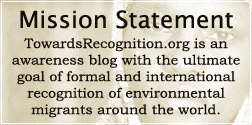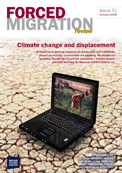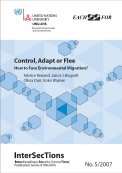(AlertNet) March 13, 2012- Disaster-prone Asia Pacific will see a surge in climate-induced migration this century and governments need to
start planning to avoid humanitarian crises caused by millions of people fleeing their homes, a new report by the Asian Development Bank (ADB) warned Tuesday.
Migration linked to climate change, a phenomenon that will “only become more pronounced in the coming years,” poses a growing humanitarian threat, said Addressing Climate Change and Migration in Asia Pacific.
The report, available in draft form last year, also said most migration in the region would be within national boundaries, and primarily from rural to urban areas. The movement, the bulk of which will involve poor people, is likely to be influenced by social, political and economic changes as well as climate pressures.
The report urged the region’s leaders to protect migrants, improve international cooperation on migrant issues, draw up more comprehensive systems to manage disaster risks, use migration as a tool to adapt to climate change and remove barriers to insurance schemes and remittances that help
communities become more resilient.
“By taking actions today, governments can reduce the likelihood of future humanitarian crises” and maximise the possibilities that people can remain in their communities or, if they are forced to move, relocate to more secure places with livelihood options, the report noted.
“People have moved for environmental reasons since the beginning of time. What has changed lately is the policy awareness about it and also how much climate change aggravates this tendency,” said Dina Ionesco, migration policy officer for the International Organisation for Migration (IOM), at the report’s launch in Bangkok.
According to IOM, currently there are
around 200 million international migrants worldwide and over 700 million internal migrants, most of them economic migrants.
42 MILLION DISPLACED BY DISASTERS
Storms, floods and other extreme weather events in Asia Pacific displaced more than 42 million people in the past two years, a share of whom became migrants, either unable to return home or opting to relocate, the report said.
The figure does not include those who moved due to slow environmental changes such as desertification, rising sea levels or coastal erosions, problems nations like the the Maldives or Papua New Guinea in particular have suffered.
Numbers of migrants as a result of slow environmental changes are much harder to calculate, partly because such changes take place over a long period of time but also because they are less visible than sudden disasters which displace thousands overnight. However, experts also say these events tend to force people to move away more permanently.
Asia Pacific is already the region most prone to natural disasters, both in terms of the absolute number of disasters and the sheer number of people exposed (60 percent of the world’s population lives in the region).
Climate change is expected to worsen the natural disaster burden, bringing sea level rise, storm surges, flooding and water stress, and leaving more people displaced, at least temporarily.
The report identifies as Asian climate risk ‘hot spots’ booming megacities including Bangkok, Jakarta and Manila, the densely populated low-lying coast of China, southern Pakistan, the deltas of the Mekong, Red and Irrawaddy rivers and the Pacific island states of Kiribati and Tuvalu.
While migration remains a controversial and sensitive issue, governments are realising the importance of a comprehensive migration and resettlement policy, said Bart W. Edes, the director of ADB’s division on poverty reduction, gender and social development.
“I think we’re aided in part by the reality around what we’re seeing – disasters after disasters,” he told AlertNet.
In the Philippines, where ADB is based, a typhoon hit northern Mindanao – an area previously not affected by typhoons – in December, killing more than 1,000 people and leaving tens of thousands displaced.
REMITTANCES FOR RESILIENCE
Coming demographic changes will bring more attention to migration in general, Edes added, and some of the solutions could be applicable to climate-induced migration. He pointed to Japan, which has signed bilateral agreements with Indonesia and Philippines to bring nurses to the country to fill gaps in the labour force left by an aging population.
“This is a practical example, in Asia, of a country that is not famous for being a big land of immigration and yet they have found it their self-interest (to do this),” he said.
The report also stressed the importance of remittances in helping communities deal with climate change and urged for fees surrounding remittances to be lowered.
“Remittances play a massive role in building resilience,” Edes said. In Bangladesh, the Philippines, Tajikistan, and Cambodia, they are “improving livelihoods, diversifying income (and) helping provide a buffer against economic shocks whether environmentally-caused or not.”
And the report singled out AfatVimo, a micro-insurance scheme in India, which covers damage or loss through 19 kinds of disasters, including floods, cyclones, lightning strikes and landslides, as an example of how to build resilience against climate impacts. The annual premium is about $4.50 with a total potential benefit of $1,560.
Migration itself is a crucial means of adapting to climate change, and ultimately affected communities should be allowed to choose to migrate, said IOM’s Ionesco.
“Migration can create alternative livelihoods for people. It can really be part of the solution if it’s well managed, well-planned, well-thought-out and well-integrated in other policies, such as humanitarian, development, adaptation and climate change policies,” she said.
“The idea is to plan and forecast this migration that can be foreseen so it’s not forced, (so) it remains a choice.”
Source: AlertNet



